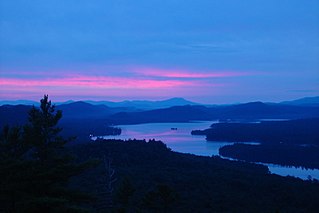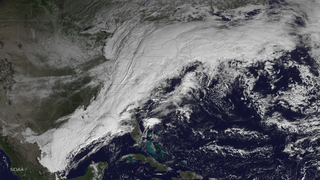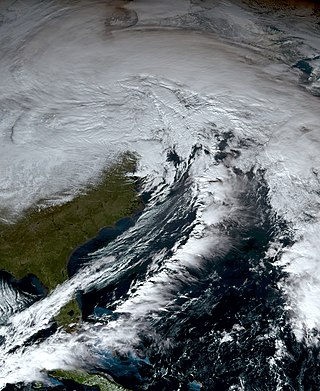
Jamestown is a city in southern Chautauqua County, New York, United States. The population was 28,712 at the 2020 census. Situated between Lake Erie to the north and the Allegheny National Forest to the south, Jamestown is the largest city in the county. Nearby Chautauqua Lake is a freshwater resource used by fishermen, boaters, and naturalists.

The New York Central Railroad was a railroad primarily operating in the Great Lakes and Mid-Atlantic regions of the United States. The railroad primarily connected greater New York and Boston in the east with Chicago and St. Louis in the Midwest, along with the intermediate cities of Albany, Buffalo, Cleveland, Cincinnati, Detroit, Rochester and Syracuse. The New York Central was headquartered in the New York Central Building, adjacent to its largest station, Grand Central Terminal.

Upstate New York is a geographic region of New York that lies north and northwest of the New York City metropolitan area of downstate New York. Upstate includes the middle and upper Hudson Valley, the Capital District, the Mohawk Valley region, Central New York, the Southern Tier, the Finger Lakes region, Western New York, and the North Country. Major cities across upstate New York from east to west include the state capital of Albany, Utica, Binghamton, Syracuse, Rochester, and Buffalo.

Western New York (WNY) is the westernmost region of the U.S. state of New York. The eastern boundary of the region is not consistently defined by state agencies or those who call themselves "Western New Yorkers". Almost all sources agree WNY includes the cities of Buffalo, Niagara Falls, Jamestown, and the surrounding suburbs, as well as the outlying rural areas of Niagara Frontier, and Chautauqua-Alleghany. Many would also place Rochester and the Genesee Valley in the region, although those legally belong in the Finger Lakes Region and are separate from Western New York Region.

The Snowbelt, Snow Belt, Frostbelt, or Frost Belt is the region near the Great Lakes in North America where heavy snowfall in the form of lake-effect snow is particularly common. Snowbelts are typically found downwind of the lakes, principally off the eastern and southern shores.
The United States District Court for the Western District of New York is the federal district court whose jurisdiction comprises the western parts of Upstate New York.

The blizzard of 1977 hit Western New York, Central NY, Northern NY, and Southern Ontario from January 28 to February 1 of that year. Daily peak wind gusts ranging from 46 to 69 mph were recorded by the National Weather Service in Buffalo, with snowfall as high as 100 in (254 cm) recorded in areas, and the high winds blew this into drifts of 30 to 40 ft. There were 23 total storm-related deaths in Western New York, with five more in northern New York.
The Golden Snowball Award is an annual award presented to the city in Upstate New York that receives the most snowfall in a season. The original award was the result of a friendly competition between National Weather Service offices in Upstate New York.
New York's 32nd congressional district was a congressional district for the United States House of Representatives in New York. It was eliminated as a result of the 1990 census. It was last represented by John LaFalce who was redistricted into the 29th district.

The Niagara Frontier refers to the stretch of land in the United States that is south of Lake Ontario and north of Lake Erie, and extends westward to Cleveland, Ohio. The term dates to the War of 1812, when the northern border was in contention between the United States and British forces in Canada. It refers only to the land east of the Niagara River and north of Lake Erie within the United States. The western side of the Niagara River, on the Canada/Ontario side, is the Niagara Peninsula; it is considered part of the Golden Horseshoe.

The October 2006 Buffalo storm was an unusual early-season lake effect snow storm that hit the Buffalo, New York, area and other surrounding areas of the United States and Canada, from the afternoon of Thursday, October 12 through the morning of Friday, October 13, 2006. It was called Lake Storm Aphid by the National Weather Service office in Buffalo, in accordance with their naming scheme for lake-effect snowstorms for that year, which related to insects, though locals never used that terminology and have simply referred to it as the October Surprise or the October Storm or Arborgeddon.

The Great Lakes Seaway Trail, formerly named and commonly known as the Seaway Trail, is a 518-mile (834 km) National Scenic Byway in the northeastern United States, mostly contained in New York but with a small segment in Pennsylvania. The trail consists of a series of designated roads and highways that travel along the Saint Lawrence Seaway—specifically, Lake Erie, the Niagara River, Lake Ontario, and the Saint Lawrence River. It begins at the Ohio state line in rural Erie County, Pennsylvania, and travels through several cities and villages before ending at the Seaway International Bridge northeast of the village of Massena in St. Lawrence County, New York. It is maintained by the non-profit Seaway Trail, Inc.

Ski country is the hilly, snowy portions of the boundary between the Niagara Frontier and the Southern Tier of the western part of New York.

The Southtowns is a region of Western New York, United States, that lies within the snowbelt or ski country. It includes the southern suburbs of Buffalo, New York. This is the common name for the southern part of Erie County, New York.

The climate of New York (state) is generally humid continental, while the extreme southeastern portion of the state lies in the warmer humid subtropical climate zone. Winter temperatures average below freezing during January and February in much of the state of New York, but several degrees above freezing along the Atlantic coastline, including New York City and Long Island.

The November 13–21, 2014 North American winter storm was a potent winter storm and particularly severe lake-effect snowstorm that affected the United States, originating from the Pacific Northwest on November 13, which brought copious amounts of lake-effect snow to the Central US and New England from November 15 until November 21, when the system departed the East Coast of the United States. The snowstorm elicited an enormous response from emergency crews and the National Guard, requiring more manpower than any other snowstorm in the history of New York state, as it buried cars and stranded thousands of people in their homes in Western New York. Eight months after the storm, the snow's remnants still remained in Buffalo, New York.

In November 2022, a severe lake-effect winter storm impacted parts of Pennsylvania, Ohio, and New York, causing high accumulations of snow across the Great Lakes region, including snowfall accumulations upwards of 50 in (130 cm) in several locations. In Hamburg, New York, 81.2 in (206 cm) fell, while Orchard Park, New York recorded 80 in (200 cm) of snow. At least four fatalities occurred, with three in New York and one in Indiana, and several highways closed after heavy snowfall. A travel ban was also issued for New York by governor Kathy Hochul, and thundersnow occurred across areas impacted by the winter storm.

From December 21 to 26, 2022, an extratropical cyclone created crippling winter storm conditions, including blizzards, high winds, snowfall, and record cold temperatures across the majority of the United States and parts of Canada. Impacted areas include parts of Minnesota, Iowa, Wisconsin, Michigan, Ohio, Pennsylvania, New York, and Ontario, with Buffalo, New York and the Fort Erie and Kingston areas of Ontario experiencing two full days of hazardous conditions and zero-visibility. The cold wave affected all U.S. states from Colorado to the Eastern Seaboard, with effects felt as far south as Miami, Florida. On December 24, 110 million people across 36 states were subject to wind chill alerts.
In late December 2022, a winter storm caused devastating impacts in the state of New York, particularly for the Buffalo metropolitan area.















